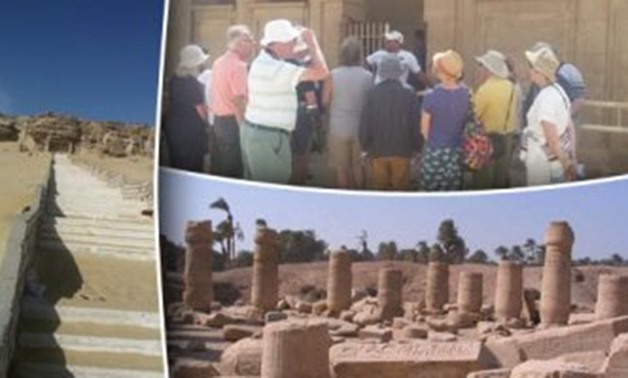
Tuna el-Gebel - A photo complied by Egypt Today.
CAIRO – 14 April 2019: The Egyptian Museum in Tahrir will organize an exhibition of the artifacts discovered in Tuna el-Gebel region in Al-Minya, which is scheduled to start on April 17.
Director of the Egyptian Museum Mohammed Ali stated that the exhibition will include a collection of pottery vessels, statues of Alabaster and a number of statues of the goddess Sekhmet, in addition to a collection of different statues, which will be presented to the public, after the completion of the temporary exhibition currently held in the museum.
The temporary exhibition in the Egyptian Museum in Tahrir comprises the findings of the excavation works of the French-Italian mission, which was launched by Minister of Antiquities Khaled al-Anani on February 4.
The French-Italian mission’s findings include 200 pieces found during excavation works in Umm al-Burajat area in Fayoum; the pieces were discovered over a span of 30years starting 1988.
Later, catacombs were dug under the necropolis; these were used to store thousands of sacred mummies of falcons, baboons and ibises.
Near to the modern entrance ofthe catacombs is the tomb of the fourth century high priest Petosiris. This sepulcher was builtto look like a temple, resembling Dendera. The outside is decorated in typical Late Period style, whereas the outer court is ornamented in a Greek style.
The tomb was constructed around the time of the conquest of Egypt by Alexander the Great, and seems to have been decorated like this to build relations with the new Ptolemaic rulers.
Tuna El-Gebel area is among the archaeological sites that contain plenty of ancient Egyptian treasures that are not yet revealed.
Minister of Antiquities KhaledAnany announced on February 4 that a joint mission from the Ministry of Antiquities and the Research Centre for Archaeological Studies at Minya University uncovered a collection of Ptolemaic-era rock burial chambers at the site of Tuna El-Gebel necropolis, Minya.
Anany added that the uncovered grave was probably for a family from the upper middle class. He explained that the discovery dates back to the beginning of the Roman era and the uncovered antique coffins date back to the late era.
Anany further explained that the newly uncovered grave consists of a number of burial chambers housing about 40 human mummies of different genders and ages, including children. All the discovered mummies are in a good condition where some are wrapped in linen or decorated with Demotic handwriting.
Head of the Supreme Council of AntiquitesMostafaWaziry explained that the techniques used to bury the mummies vary in style as some of the mummies were buried inside stone or wooden sarcophagi, while others were buried in sand or were placed on the floors of the tombs or inside niches.
This is the burial style used in Tuna El- Gebel, which was the necropolis of Egypt’s 15th Nome during the late New Kingdom and the beginning of the New Intermediate Period.
Waziry added that fragments of papyri were also uncovered in the tomb, the matter that indicated that it could date to the Ptolemaic, early Roman orByzantine periods.
Head of the archaeological mission Wagdi Ramadan said that the mission started its work in Tuna El-Gebel in February 2018.
Minister of Tourism Rania al-Mashat said that this discovery sendsan important message to the whole world that Egypt “has it all.”
Also,the minister previously announced on Feb. 24, 2018 the discovery of eight tombs that contain about 40 coffins of Pharaonic priests and more than 1,000 Ushabti statues in Tuna El-Gebel. The tombs were full of jewellery, potteries and jars.
Anany described this discovery as one of the largest and most important archaeological discoveries in recent times because it documents significant issues related to the live of ancient Egyptians in Minya tens of centuries ago.
The most prominent finds in these tombs were a gold mask, coffins, mummies and statues.
The Egyptian minister of antiquities added that it will take a lot of hard work to uncover all Tuna El-Gebel's treasures, pointing out that the main advantage of this discovery is that it was made by Egyptians.
Furthermore, archaeologists at Cairo University have discovered catacombs including 18 non-royal mummies in Tuna El-Gebel on Saturday May 13, 2017.
The burial shafts were found in the area and the shafts led to a number of corridors containing a cachet of mummies. This discovery was the first human necropolis found in central Egypt with so many mummies.
Tuna El-Gebel, in the city of Mallawi, in Minya was the necropolis of Khmun.
It contains monuments from the Greek and Roman eras, as well as the Late Middle Ages.
The area hosts the Boundary Stelae of Akhenaton, catacombs of falcons, baboons and ibises, and the tombs of Petosiris and Isadora, goddess of Thoth, the vaults and the Roman passageway.
The oldest monument in the area is the Boundary Stelae of Akhenaten, up in the cliffs, protected by a glass 'booth'. This makes it quite difficult to see properly, but prevents further erosion.
Tuna El-Gebel was originally named “Towns" in the Pharaonic era and "Tahnet" in the Roman era. The meaning of both names is the blessing or flood.

Comments
Leave a Comment